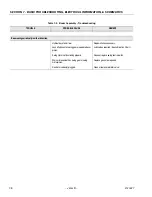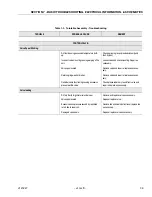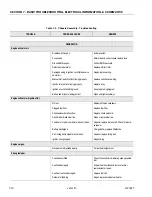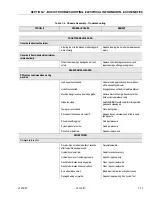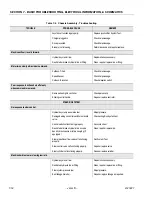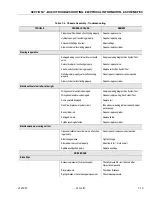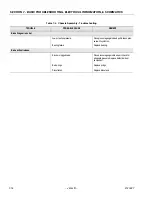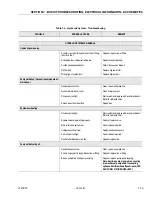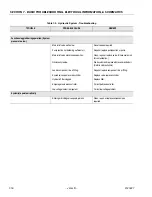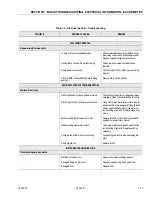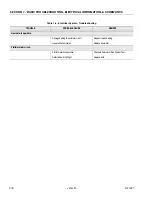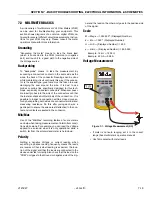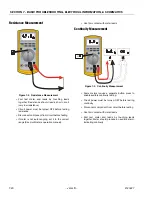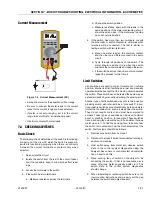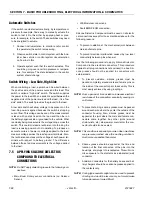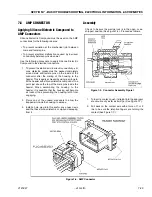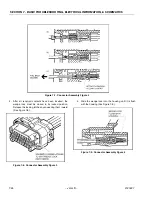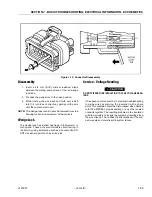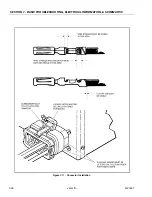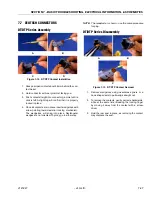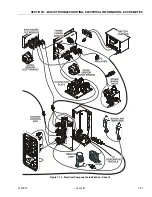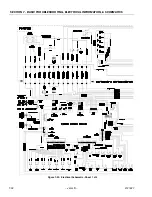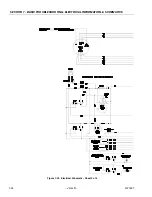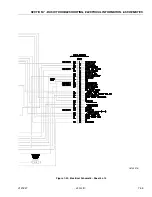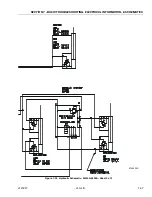
SECTION 7 - BASIC TROUBLESHOOTING, ELECTRICAL INFORMATION, & SCHEMATICS
7-22
– JLG Lift –
3121827
Automatic Switches
If the switch is actuated automatically, by temperature or
pressure for example, find a way to manually actuate the
switch to test it. Do this either by applying heat or pres-
sure, for example, to the switch. These switches may need
to be energized to actuate.
1. Connect instrumentation to monitor and/or control
the parameter the switch is measuring.
2. Observe switch state in control system with the Ana-
lyzer. See vehicle or control system documentation
on how to do this.
3. Operate system such that the switch actuates. This
could be going over a certain pressure or tempera-
ture, for example. The state indicated in the control
system should change.
Switch Wiring - Low Side, High Side
When controlling a load, a switch can be wired between
the positive side of the power source and the load. This
switch is called a "high side" switch. The switch supplies
the power to the load. When a switch is wired between the
negative side of the power source and the load, it is a "low
side" switch. The switch provides the ground to the load.
A low side switch will allow voltage to be present on the
load. No power is applied because the switch is stopping
current flow. This voltage can be seen if the measurement
is taken with one test lead on the load and the other on
the battery negative side or grounded to the vehicle. What
is actually being measured is the voltage drop across the
switch. This could mislead a technician into thinking the
load is receiving power but not operating. To produce an
accurate picture of power or voltage applied to the load,
measure voltage across the load’s power terminals. Also,
the technician can measure the voltage at both power ter-
minals with respect to battery ground. The difference
between those two measurements is the voltage applied
to the load.
7.5 APPLYING SILICONE DIELECTRIC
COMPOUND TO ELECTRICAL
CONNECTIONS
NOTE:
Do NOT apply dielectric grease to the following con-
nections:
• Main Boom Rotary sensor connections (on Celesco
Sensor),
• LSS Modules connections,
• Deutz EMR 2 ECM connection.
Silicone Dielectric Compound must be used on all electri-
cal connections except for those mentioned above for the
following reasons:
• To prevent oxidation at the mechanical joint between
male and female pins.
• To prevent electrical malfunction caused by low level
conductivity between pins when wet.
Use the following procedure to apply Silicone Dielectric
Compound to the electrical connectors. This procedure
applies to all plug connections not enclosed in a box. Sili-
cone grease should not be applied to connectors with
external seals.
1. To prevent oxidation, silicone grease must be
packed completely around male and female pins on
the inside of the connector prior to assembly. This is
most easily achieved by using a syringe.
NOTE:
Over a period of time, oxidation increases electrical
resistance at the connection, eventually causing cir-
cuit failure.
2. To prevent shorting, silicone grease must be packed
around each wire where they enter the outside of the
connector housing. Also, silicone grease must be
applied at the joint where the male and female con-
nectors come together. Any other joints (around
strain reliefs, etc.) where water could enter the con-
nector should also be sealed.
NOTE:
This condition is especially common when machines
are pressure washed since the washing solution is
much more conductive than water.
3. Silicone grease should be applied at the time and
location of the final connection of the pins into the
housings, and plugs into receptacles. This will mini-
mize exposure to the elements as a lubricated (wet)
connector.
4. Anderson connectors for the battery boxes and bat-
tery chargers should have silicone grease applied to
the contacts only.
NOTE:
Curing-type sealants might also be used to prevent
shorting and would be less messy, but would make
future pin removal more difficult.
Summary of Contents for JLG E400AJP
Page 2: ......
Page 32: ...SECTION 1 SPECIFICATIONS 1 18 JLG Lift 3121827 NOTES...
Page 42: ...SECTION 2 GENERAL 2 10 JLG Lift 3121827 NOTES...
Page 54: ...SECTION 3 CHASSIS TURNTABLE 3 12 JLG Lift 3121827 Figure 3 3 Speed Sensor Orientation...
Page 60: ...SECTION 3 CHASSIS TURNTABLE 3 18 JLG Lift 3121827 Figure 3 7 Steering Components and Spindles...
Page 62: ...SECTION 3 CHASSIS TURNTABLE 3 20 JLG Lift 3121827 Figure 3 9 Tilt Sensor Location...
Page 86: ...SECTION 3 CHASSIS TURNTABLE 3 44 JLG Lift 3121827 Figure 3 16 Swing Components...
Page 88: ...SECTION 3 CHASSIS TURNTABLE 3 46 JLG Lift 3121827 Figure 3 18 Battery Cable Connections...
Page 90: ...SECTION 3 CHASSIS TURNTABLE 3 48 JLG Lift 3121827 Figure 3 20 On Board Generator...
Page 97: ...SECTION 3 CHASSIS TURNTABLE 3121827 JLG Lift 3 55 Figure 3 22 Generator Components...
Page 116: ...SECTION 3 CHASSIS TURNTABLE 3 74 JLG Lift 3121827 NOTES...
Page 127: ...SECTION 4 BOOM PLATFORM 3121827 JLG Lift 4 11 Figure 4 10 Boom Limit Switches...
Page 140: ...SECTION 4 BOOM PLATFORM 4 24 JLG Lift 3121827 Figure 4 13 Rotator Counterbalance Valve...
Page 178: ...SECTION 5 HYDRAULICS 5 24 JLG Lift 3121827 Figure 5 26 HydraForce Cartridge Torque Value Chart...
Page 214: ...SECTION 6 JLG CONTROL SYSTEM 6 34 JLG Lift 3121827 NOTES...
Page 257: ......

